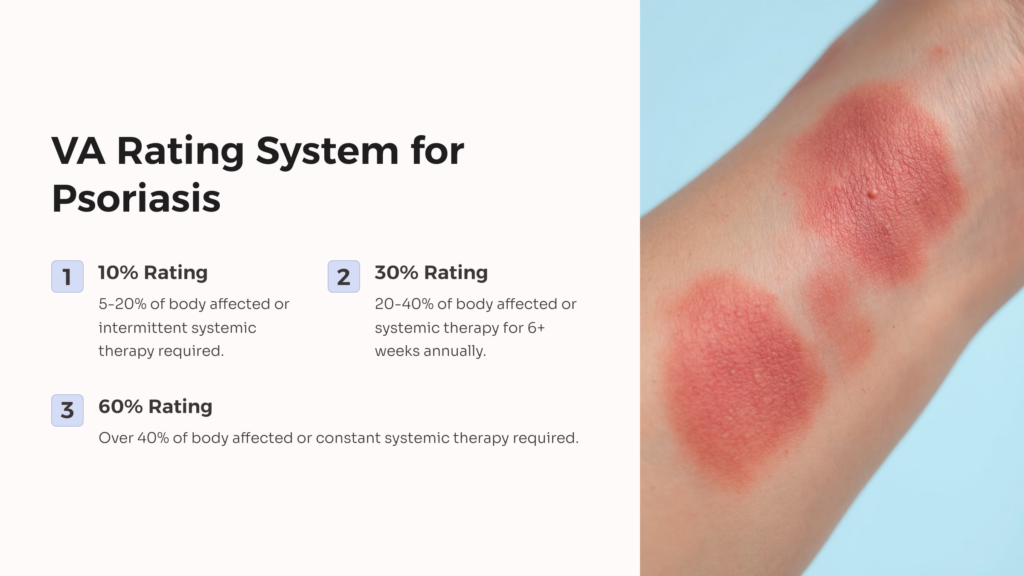Psoriasis is a chronic skin condition that affects millions of veterans. The Department of Veterans Affairs (VA) recognizes psoriasis as a service-connected disability, providing benefits to those who developed or aggravated the condition during their military service. Understanding how the VA rates psoriasis is crucial for veterans seeking compensation.
The VA uses a specific rating system to evaluate the severity of psoriasis and determine the level of disability compensation. This rating system is based on the percentage of body area affected and the impact on daily life. Veterans should familiarize themselves with this system to ensure they receive fair and accurate compensation for their condition.
It’s important to note that psoriasis ratings can range from 0% to 100%, depending on the severity and extent of the condition. Even a 0% rating can be beneficial, as it acknowledges service connection and may allow for future increases if the condition worsens.

How the VA Rates Psoriasis
The VA rates psoriasis under 38 CFR § 4.118, Diagnostic Code 7816. This code provides specific criteria for evaluating the severity of psoriasis. The rating is primarily based on two factors: the percentage of the entire body affected and the percentage of exposed areas affected.
A 10% rating is assigned when at least 5% but less than 20% of the entire body or exposed areas are affected. Alternatively, a 10% rating may be given if intermittent systemic therapy, such as corticosteroids or other immunosuppressive drugs, is required for less than six weeks during the past 12-month period.
For a 30% rating, 20% to 40% of the entire body or exposed areas must be affected. This rating may also be assigned if systemic therapy is required for six weeks or more, but not constantly, during the past 12-month period.
The highest rating of 60% is given when more than 40% of the entire body or exposed areas are affected, or if constant or near-constant systemic therapy was required during the past 12-month period.
Documenting Psoriasis for VA Rating

To receive an accurate VA psoriasis rating, proper documentation is essential. Veterans should keep detailed records of their condition, including:
- Medical diagnoses and treatment records
- Photographs of affected areas during flare-ups
- Logs of medication usage, including frequency and duration
- Notes on how psoriasis impacts daily activities and quality of life
These records will help provide a comprehensive picture of the condition’s severity and its effects on the veteran’s life. It’s also crucial to have regular check-ups with a dermatologist or primary care physician who can document the extent and progression of the condition.
Veterans should be prepared to undergo a Compensation and Pension (C&P) exam, where a VA-appointed healthcare provider will assess the severity of their psoriasis. During this exam, it’s important to be honest and thorough about symptoms and their impact on daily life.
Common Challenges in VA Psoriasis Ratings
Veterans often face challenges when seeking appropriate ratings for their psoriasis. One common issue is the fluctuating nature of the condition. Psoriasis can have periods of remission and flare-ups, making it difficult to accurately assess the overall severity.
Another challenge is the subjective nature of some rating criteria. For example, determining the exact percentage of body area affected can be open to interpretation. This is why thorough documentation and clear communication with healthcare providers are crucial.
Some veterans may also struggle with proving service connection, especially if the condition developed or worsened after leaving the military. In such cases, it’s important to gather evidence linking the condition to military service, such as exposure to certain environmental factors or stress.
Appealing a VA Psoriasis Rating Decision

If a veteran disagrees with their assigned psoriasis rating, they have the right to appeal the decision. The appeals process involves several steps:
- Filing a Notice of Disagreement (NOD)
- Requesting a Decision Review Officer (DRO) review
- Submitting additional evidence to support the claim
- Attending a hearing, if necessary
During the appeal process, veterans can provide new medical evidence, statements from family or fellow service members, and any other relevant information that supports their claim for a higher rating.
It’s often beneficial to seek assistance from a Veterans Service Organization (VSO) or an experienced VA disability attorney when navigating the appeals process. These professionals can help ensure all necessary documentation is submitted and advocate on the veteran’s behalf.
Impact of Psoriasis on Other VA Ratings
Psoriasis can affect more than just the skin. In some cases, it can lead to other conditions that may be eligible for separate VA ratings. For example, psoriatic arthritis is a common complication that can significantly impact a veteran’s mobility and quality of life.
Veterans who develop psoriatic arthritis or other related conditions should inform the VA and seek separate ratings for these issues. This approach can potentially increase the overall disability rating and corresponding compensation.
It’s also worth noting that the psychological impact of psoriasis, such as anxiety or depression, may be eligible for separate ratings. Veterans should discuss these aspects with their healthcare providers and include them in their VA claims if applicable.
Maintaining and Updating VA Psoriasis Ratings

Once a VA psoriasis rating is established, it’s important to understand that it’s not necessarily permanent. The VA may schedule periodic re-evaluations to assess the current severity of the condition. These re-evaluations typically occur every 2-5 years, depending on the nature and stability of the condition.
Veterans should continue to document their condition and any changes in severity or treatment. If the psoriasis worsens over time, they can file for an increased rating. Conversely, if the condition improves significantly, the VA may propose to reduce the rating.
Staying proactive about medical care and documentation can help ensure that the VA rating accurately reflects the current state of the condition. Regular check-ups with healthcare providers and maintaining a personal record of symptoms and treatments are crucial steps in this process.
Resources for Veterans with Psoriasis
Several resources are available to veterans dealing with psoriasis:
- VA healthcare facilities often have dermatology departments specializing in skin conditions like psoriasis
- The National Psoriasis Foundation offers support and information specific to veterans
- Veterans Service Organizations (VSOs) can provide guidance on navigating the VA system
- Online support groups and forums allow veterans to connect with others facing similar challenges
These resources can provide valuable information, support, and assistance in managing psoriasis and navigating the VA rating system.
Final Thoughts on VA Psoriasis Ratings
Understanding and navigating the VA psoriasis rating system can be complex, but it’s an important process for veterans seeking fair compensation for their condition. By staying informed, maintaining thorough documentation, and seeking appropriate medical care, veterans can work towards receiving accurate ratings that reflect the true impact of their psoriasis.
Remember that the VA rating system is designed to compensate for the average impairment in earning capacity caused by the condition. While it may not capture every aspect of living with psoriasis, it aims to provide fair compensation based on standardized criteria.
Veterans should not hesitate to seek help when needed, whether from healthcare providers, VSOs, or legal professionals. With persistence and proper documentation, veterans can work towards receiving the compensation they deserve for their service-connected psoriasis.
Get a jumpstart on benefits today by taking our free medical evidence screening at AllVeteran.com.
 AllVeteran.com Advisors
AllVeteran.com Advisors
With expertise spanning local, state, and federal benefit programs, our team is dedicated to guiding individuals towards the perfect program tailored to their unique circumstances.











